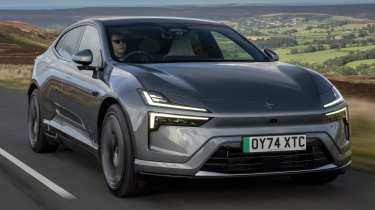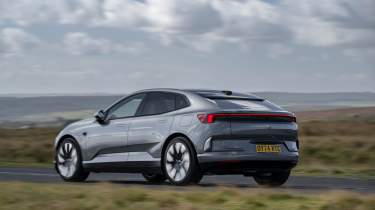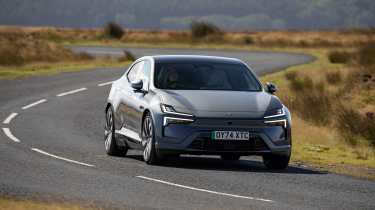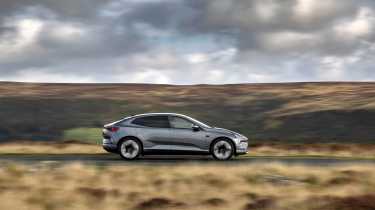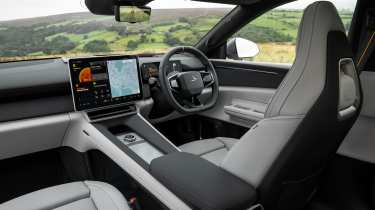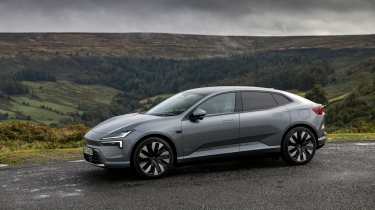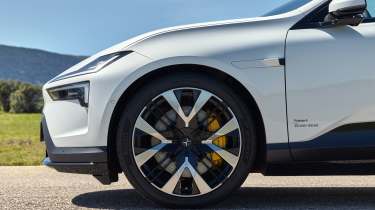Polestar 4 2024 review – 536bhp crossover is the fastest yet
The Polestar 4 is a style and performance statement that greatly appeals, even if it lacks the absolute dynamic polish of some rivals
In spite of its insistence that it remains a niche luxury marque without a focus on raw volumes, Polestar has in 2024 introduced no fewer than two crossover SUVs. Arriving in the UK market in tandem are the E segment Polestar 3 luxury SUV and now the Polestar 4, a sloped-back D segment sports crossover with concept car looks. In so doing, Polestar goes from a one-model to a three-model marque, with the 3 and 4 joining the Polestar 2.
Soon, they will be joined by the Polestar 5 – a Porsche Taycan fighter – and Polestar 6 flagship EVs, that are to ride on a bespoke platform developed in the UK. For now though, it is to the Polestar 3 and Polestar 4 that we look, to get a feel for its evolving aspirations, with eyes firmly set on the German monoliths and popular upstarts.
To draw customers away from the Porsche Macan EV, Audi Q6 e-tron and Tesla Model Y, the Polestar 4 is going to have to be a seriously competent and complete car.
Polestar 4 performance, dynamics and range
The Polestar 4’s opening gambit is that it is unequivocally the fastest, most potent Polestar yet. Yes, somewhat confusingly, the Polestar 3 is the more expensive car positioned in a higher-end segment, while the Polestar 4 is the fastest in dual-motor form.
More reviews
Group tests
- Alpine A290 v Alpine A110 – how much DNA do they really share?
- Ariel Atom 4R v Caterham Seven ‘evo25’: power-to-weight heroes go head-to-head
- Caterham Super Seven 600 v Super Seven 2000
- Levante v T1
- Corvette Stingray v Porsche Cayman GTS v Audi R8 RWD
- Great Ferrari hypercars driven: 288 GTO, F40, F50 and Enzo head-to-head
- Hardcore Ferrari V8 specials go head-to-head
- Lamborghini Aventador Ultimae v Lamborghini Countach
- Lotus Emira v Morgan Plus Four – four-cylinder Brits go head-to-head
- Toyota GR86 v BBR Mazda MX-5: supercharged drop-top battles sports coupe
In-depth reviews
- Abarth 600e 2025 review – Italy gives the Alpine A290 something to worry about
- Alpine A110 review – distinctive, lightweight and unforgettable to drive
- Audi R8 (2015 - 2024) review – the ultimate soft-focus supercar
- Bentley Continental R Mulliner: review, history and specs
- BMW 5-series review – is this still Munich’s anchor model?
- BMW 1-series review – Munich’s Audi A3 rival gains focus
Long term tests
- Abarth 695C Turismo Fast Fleet test – 10,000 miles in the Italian hot hatch
- Alfa Romeo Giulia Veloce Fast Fleet test – 7000 miles in the sharp Italian saloon
- Alpina B10: end of term report
- Alpina B10
- Ford Mustang GT
- Ford Mustang GT
- Ford Mustang GT
- Land Rover Defender 110 Fast Fleet test – 9000 miles in the go-anywhere SUV
- Maserati Ghibli Trofeo Fast Fleet test – 4000 miles in the Ferrari-powered saloon
- Mitsubishi Evo MR 340
Review
- New Aston Martin DBS 770 Ultimate review – 759bhp super-GT driven
- New Bentley Batur 2023 review – can it possibly be worth £1.65m?
- 2023 Chevrolet Corvette C8 Z06 review – the American 911 GT3?
- Kia EV6 GT-Line S prototype review – the EV that shows how it’s done
- BBR Supercharged Mazda MX-5 (ND) 2023 review – tuned 250bhp roadster driven
- MG4 Trophy 2023 review
Reviews
- Abarth 695 75 Anniversario edition 2024 review – a fitting send-off for Abarth’s hot supermini?
- Abarth 500e 2023 review
- AC Cobra 378 Superblower MkIV 2021 review – another V8 Cobra, but with a GM heart this time
- Acura Integra Type S 2024 review – a Honda Civic Type R with added restraint
- Alfa Romeo Giulia 2025 review – get one while you still can
- Alfa Romeo SZ: history, review and specs of an icon
- Alfa Romeo 1750 TBi
- Alpina B3 GT Touring 2025 review – a 190mph alternative to the BMW M3 Touring
It rides on the Geely Sustainable Experience Architecture, which also underpins the Volvo EX30. In fact, the Polestar 4 has more in common with the Lotus Eletre, architecturally, than it does the Polestar 3, which rides on the SPA2 architecture that also underpins the Volvo EX90. Keeping up?
The choice to plunder the Geely parts bin was one of convenience for Polestar and is part of what has allowed it to bring multiple new products to market in such a short space of time. With 400-volt electronics it’s not technologically the most advanced by comparison to the 800-volt, PPE-based Porsche Macan EV and Audi Q6 e-tron, with DC charging only up to 200kW.
But you can certainly have power if you want it. The long range, dual motor car with the performance pack that we drove packs a quite dizzying 536bhp and 506lb ft. Those motors are fed by a 94kWh (usable) battery which can, when not being plumbed for a 3.7-second 0-60mph time, deliver a claimed 367 miles of WLTP-certified range. In the real world, that’s more in the region of 300 on average, depending on conditions and driving styles – reasonable when you consider the available performance.
That can happily be metered out with adjustable powertrain settings. Performance mode means both motors are working all the time, with the full 536bhp available at any moment. Range mode disconnects the front motor in normal driving but is able to reconnect near-instantly should you drop the throttle and ask for the full beans. If anything, deploying the full 536bhp glob can be as unnerving as it is thrilling, with the wheels often tramping and juddering in the arches as the tyres try to find purchase.
Indeed, with all that punch on offer, you’d hope the rest of the package is up to the job of harnessing it. The Polestar 4 is suspended by coils front and rear with active ZF dampers that can be set in Normal, Nimble or Firm settings. On the road at pace, Nimble is the happy medium, with Normal not affording the kind of control you’d want for a car as fast as this and Firm doing exactly as advertised, stiffening the road ride almost to the point of intolerability.
That’s not to say the Nimble setting is ideal, with the big 22-inch forged wheels juddering in the arches over sudden imperfections and the mass escaping you on occasion through rapid direction and elevation changes. Off the back of driving the more sophisticated-feeling, air-sprung Polestar 3, one can’t help but wonder if air suspension would have elevated the Polestar 4 experience too. Its omission is a function of price management for the Polestar 4, we’re told. The same is likely the case for the Polestar 3’s BorgWarner limited-slip differential that, in spite of it being more powerful, cannot be had on the Polestar 4.
The steering weight is adjustable too through light, standard and firm. Firm is the heaviest setting – that’s not really heavy at all – and seems to feel the most natural for what is a 2,355kg car at the kerb. Unsurprisingly, there’s little in the way of tangible steering feel in the traditional sense.
Happily, the Performance pack does get potent Brembo four-piston brakes at the front clamping 364mm discs that have little trouble reigning in the epic speeds the Polestar 4 is capable of. The metering of braking power through the pedal’s travel is good and the pedal feel evolves depending on what suspension mode you’re in, with Firm yielding a strangely gravelly texture underfoot. Regeneration is configurable too, with the option also of turning it all the way off. Indeed some at Polestar subscribe to the school of thought that ‘sailing’ instead of using regeneration, is actually more efficient.
Overall, the Polestar 4’s dynamics just aren’t honed and tightened to the standard of some rivals. The experience isn’t so much engaging as it is fascinating, as you watch and feel the platform try to muster up the capability to deploy the furious performance with a sense of containment and decorum. In practice, this is an enormously capable car across ground that stays dignified on the right roads, with the right surface and the right flow. But as soon as things get a bit too tight, a bit too rough under the wheels and a bit too topographically challenging, the Polestar 4 can feel like it trips over itself.
That comes as less of a surprise than the fact this car – designed for a broader audience – can be had with as much power and performance in the first place. For what it is, it does enough with what it has and if anything, what they’ve managed to make this car achieve with a borrowed and adapted platform, excites us for what the bespoke platform, British-developed Polestar 5 and Polestar 6 could be like.
Polestar 4 interior and design
Inside the Polestar 4 is a cool, calm, and very Scandinavian place in which to find yourself. The enormous panoramic roof – enabled by there being no back window – adds a concept car-like airiness, as does a clear view out and plenty of space. Our car had sustainable tailored knit trim which was both satisfying to look at and to the touch, though some upper layer panels on the doors did creak when driving. A very Tesla-esque crisp and clear 15.4-inch panoramic screen dominates the dashboard and features a Google-powered Android Automotive OS that’s intuitive and responsive – to the point you don’t feel the immediate urge, as in some cars, to mirror your smartphone. As ever, a few more physical buttons pertinent to the most regularly-used functions would have been nice but the Polestar 4’s UI is certainly not unnavigable.
What leaves a bit to be desired is the steering wheel, particularly with its haptic-powered touch controls. Whether it was just a calibration issue, a problem with our particular car or otherwise, the haptics on the right-hand side barely worked, with the rocker under the touch panel seemingly faulty. That meant adjustment of key areas – from the mirrors, to the head-up display and steering wheel position – was difficult from the get go.
Speaking of mirrors, the windowless rear end is actually fine thanks to the rear view mirror that displays the view of a camera from the outside. A problem if it goes wrong? Yes. A bit weird in terms of acclimatising your depth perception? At first. But it’s surprisingly intuitive. It pays off when you’re sitting in the back too – the Polestar 4 feeling like a concept car for rear seat passengers. It’s spacious, airy for it not having a rear window and just a nice place to be.
The styling of the Polestar 4 is definitely a major highlight. It’s a modernist slice of sino-Scandinavian acrylic and could be a storm trooper’s daily driver in white. Where the Polestar 3 is stylish but a little more anonymous, the Polestar 4 has people cricking their necks to get a look. It’s properly sci-fi and properly cool and easily the most interesting to look at next to a Model Y, Macan and Q6. All four doors being pillarless only adds to the sense of occasion too, though what they gain in style they lose in a slightly rattly door shut sound.
The Polestar 4 doesn’t deliver a groundbreaking drive to match its groundbreaking looks, even if it is spectacularly fast – it probably splits the difference between the Macan and Q6. That’s far from a bad showing and in the real world with the kinds of people these cars are aimed at, the amazing looks, ergonomic design, potent performance and commendable electric range deserve to impress.
Polestar 4 price, availability and rivals
Polestar 4s are available to order now. Plump for a 268bhp rear-drive single motor and prices start from £59,990, for a car that is rated for 385 miles on a full charge, with all Polestar 4s using the same battery.
As standard the Polestar 4 long range dual motor starts from £66,990, though the Performance Pack jumps our car immediately to over £70,000, adding the big brakes, 22-inch forged wheels, the adaptive dampers and the distinctive gold seatbelts inside.
The Pilot Pack adds adaptive cruise, increased lane assist and speed assist capabilities and the Park Assist 360-degree 3D view camera. The Plus Pack is included at this level, which brings everything from the excellent 12-speaker Harman Kardon Premium sound system, 14.7-inch HUD and more.
All up our car had a sturdy £75,040 price as tested, which is about on the money for where the less powerful, not as fast Porsche Macan 4S Electric starts. The Audi SQ6 e-tron is both down on power compared to this Polestar and costs from £93,000. It is more SUV-ish, though we expect a more rakish Sportback is on the way. The bombastic Kia EV6 GT offers competitive performance for the money, looks great but doesn't run the Polestar even close for usable range. The Tesla Model Y also undercuts the Polestar on price, with the Performance starting from £59,990. It’s also worth remembering the Tesla Model Y is due a significant update very soon, in line with the recently-refreshed Model 3.
